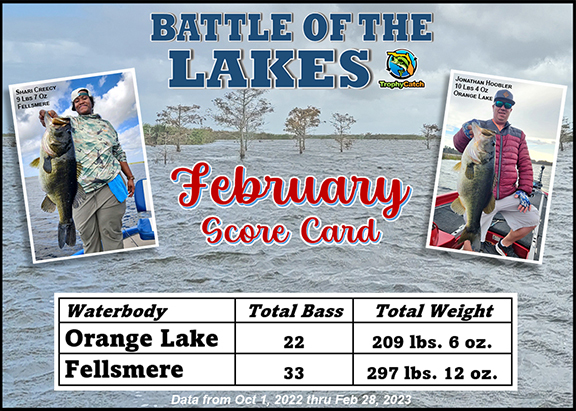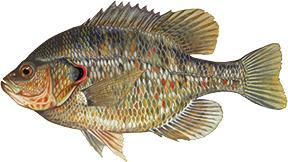|
Michael Matthews is the current Season 11 Leader with this 13 lbs. 8 oz. catch from Orange Lake.
The TrophyCatch Season Leader at the end of March is Michael Matthews’ 13 lbs. 8 oz. monster from Orange Lake. It’s no coincidence that the current leader is from one of the two "Battle of the Lakes" waters; see below for details! Good luck and tight lines to all of our TrophyCatch anglers and our Orange Lake and Headwaters contenders!
Heather Cogar contributed to the data below with her "First ever bass I’ve caught," which weighed 9 lbs. 6 oz.!
TrophyCatch Season 11 is the Season of Research, as we celebrate what YOUR bass submissions are teaching us about our favorite fish. Here are some interesting facts that have been gleaned from your data since the program was launched in 2012:
- 9%, or almost one out of every 10 approved TrophyCatches, were caught in tournaments.
- Osceola County has more TrophyCatch approvals than any other Florida county.
- Over 400 public waterbodies have TrophyCatch approved bass.
- The largest TrophyCatch caught from a kayak was 15 lbs., a truly amazing feat.
- 41% of Hall of Fame bass weighing 13 lbs. or more were caught on a plastic worm. You just can’t go wrong fishing one!
Currently at the end of March, TrophyCatch submission numbers stand at:
- 11,024 Lunker Club (8-9.9 lbs.)
- 2,766 Trophy Club (10-12.9 lbs.)
- 133 Hall of Fame (13+ lbs.)+
- 13,923 TOTAL approved submissions to date
That’s an incredible number of trophies caught, documented, and released for fellow anglers to recapture!
Also, the brand-new Season 11 Phoenix TrophyCatch bass boat has arrived! It is making its way to various events throughout the state to provide a sneak peek at the ride a lucky TrophyCatch participant will be taking home at the end of this year. Phoenix Boats, Mercury Marine, Lowrance, Power-Pole, Wrap This! and other partners make this amazing annual prize possible.
Keep your eyes open for the Season 11 Phoenix TrophyCatch bass boat at events around the state. This could be your ride by the end of the year!
In other news, the “Battle of the Lakes” has launched as anglers compete to submit the heaviest total weight of fish from either Orange Lake or Headwaters (Fellsmere Reservoir). The February standings are listed below, but the season is still early and there is still plenty of time to hit your favorite spot and put it at the top! Rules and details can be found at https://www.trophycatchflorida.com/rules.aspx#battle.
 |

Size: Size: The state record is 4.86 pounds. The Big Catch minimum qualifying sizes are 1.25 pounds or 11 inches for adults, and 1.00 pound or 8 inches for youth (see BigCatchFlorida.com).
Appearance: The redear sunfish is easily distinguished from other "bream" species by the unique red or orange margin on the gill flap (or opercle). It also grows larger than the other sunfish species, regularly exceeding a pound. The top of the body is dark olive, with the sides and underside being yellow to orange in color (sometimes with a sprinkling of red spots). Dark vertical bars may also be present.
Range & Habitat: Redear sunfish are abundant in waters throughout Florida, but some of the best locales include the Yellow River, Orange Lake, Lake Tarpon, the Winter Haven Chain of Lakes, Lake Istokpoga, and the Everglades Water Conservation Area canals.
Sporting Quality: This popular sportfish is the largest of our bream and fights well on light tackle. Live worms, crickets and grass shrimp make excellent baits. Lure anglers should use small jigs, beetle spins or spinners. Fly anglers can use almost any wet fly or nymph, although a small popping bug remains the perennial favorite. Redears may be found spawning throughout the spring and summer well into August, and locating a group of beds can lead to some fast and steady action. This fish also goes by the name of “shellcracker,” due to its preference for small snails and clams (and more specifically, the hard plates in the back of its mouth used for breaking open these delicacies). Its feeding habits make it likely to be found somewhat deeper and closer to the bottom than other sunfish species.
Fish illustration by Duane Raver, Jr.
|
 |
De-barbing your hooks will make things easier for fish and fisher alike.
A recent public fishing event showcased the importance of barbless hooks. Most of the participating youth and adults had little or no experience fishing. The results were predictable: many fish were hooked well after they took the bait, and no nearby bush or tree was safe! However, by the end of the event, every single fish was released alive, and nearly all were unhooked and released within seconds of being landed. The barbless hooks rigged for the event get the credit for both the high survival rate of the fish and a smooth fish handling experience for the participants.

Barbless hooks make life easier for experienced anglers as well, especially those with limited time who prefer to be making their next cast to extracting a deeply embedded barbed hook. It's especially important to use barbless hooks for bait fishing, where a hook might get swallowed deeply. With few exceptions, most baits will stay in place on de-barbed hooks. Circle hooks (including barbless circle hooks) are also an excellent alternative and provide good results with most fish usually hooked in the corner of the mouth. For smaller fish like bream, a de-barbed Aberdeen hook works well because the long shank is easy to grab and remove with fingers or pliers.
Bigger lures with multiple treble hooks are also prime candidates for de-barbing. If a fish does become fouled by a lure (such as a three-trebled minnow imitation, a favorite for bass), it’s much easier to “untangle” than it would be with barbs preventing hook points from being removed.
For de-barbing your hooks, use a small pair of needle-nosed pliers. If you can find a pair with a flat, non-serrated surface, that seems to work a bit better at mashing barbs entirely flat.
One of the few potential drawbacks of going barbless is the possibility of more lost fish that throw the hook. Keeping a tight line will reduce most such losses. In fact, the “big fish” from another youth fishing event was a four-pound bass landed on a tiny, barbless #8 Aberdeen after a several-minute battle. The inexperienced angler kept the line tight by reeling like crazy, drag slipping, the entire time — but he got his fish to shore. So be willing to take a lesson from the inexperienced: de-barb those hooks, for you and for the fish!
|
 |
Size: 130 acres
Location: Holmes County
Lake Victor is a 130-acre artificial impoundment constructed in 1966 and opened to fishing in 1968. It has an average depth of 8 feet and a maximum depth of 23 feet. Deepest areas are near the dam and along the old stream bed. A considerable amount of timber remains, providing fish habitat and cover. The lake has been previously stocked with sport fish including largemouth bass, bluegill, redear sunfish (shellcrackers), and channel catfish. Lake Victor also supports a good population of black crappie which appear to peak every 5 to 7 years. The lake is located in north Holmes County, south of S.R. 2, approximately one mile west of the New Hope community. It is within easy commuting distance from Chipley, Bonifay, DeFuniak Springs, and south Alabama. There is a concrete boat ramp with ample parking located near the dam on the northeast side of the lake.
A fishing license is required for residents, 16-64 years of age, and non-residents, 16 years of age or older, to fish by any method (including cane poles). As a fish management area Lake Victor possesses special regulations that differ from the statewide regulations. These regulations include:
Boating
- Gasoline powered motors are prohibited, only electric motors are permitted for use.
- No motor vehicles are allowed on the dams, spillways, or fishing fingers.
Daily Bag Limits
-
Largemouth Bass, CORRECTED: Black bass bag limit: 15. Black bass 16 inches in total length or longer must be released immediately. Circle hooks required when fishing with natural bait greater than 3" in length.
-
Channel Catfish: Daily bag limit of 6 per angler.
The Florida FWC manages Lake Victor’s fishing resources with a variety of different methods:
-
Fish Attractors – Brush and other materials have been placed in the lake to concentrate fish and improve angler harvest. Most recently while the lake was drawn down, brush attractors and wooden catfish boxes were added to the lake bottom near the fishing pier and dam.
-
Fish Stocking – Various species (channel catfish, bream, bass, and crappie) are stocked periodically to provide unique and exciting sportfishing opportunities.
Fish Species:
Bluegill and Redear Sunfish – Often referred to as “bream,” Lake Victor holds several species of sunfish. Congregating around structure, vegetation, or spawning over bare spots on the bottom, known as “bream beds,” these panfish can provide nonstop excitement for anglers. Crickets, worms, or even jigs fished underneath a cork are effective methods. A small rooster tail spinner or beetle spin can also provide a fun way to catch these feisty fish. In the panhandle of Florida, they are usually most active in the late spring into the summer. As the water temperature ranges from 68 to 80 degrees, the bream should begin to gather on beds throughout the lake. During most years, anglers can expect this to begin in late-March and last through September. Redear Sunfish (shellcracker) tend to nest in “communities,” meaning there will often be numerous nests built in the same area. Bluegill will often use the same nesting areas previously used by shellcracker and also tend to nest in “communities.” Light tackle with earthworms, crickets, beetle spins, rooster tails, or small jigs can produce nice redear sunfish and bluegill.
Largemouth Bass – This popular sportfish tends to hang around structure or vegetation. In the springtime, they can be targeted spawning in shallower areas of the lake while they generally seek deeper, cooler water during the summer. Plastic worms, spinner baits, crankbaits, and even topwater lures can all be used to catch these aggressive fish. As water temperatures move into the upper 70s and higher, anglers fishing during dawn and dusk can often catch fish moving into shallow water to feed. Plastic worms and lizards rigged Carolina- or Texas-style, along with Rat-L-Traps and crankbaits can all be effective. If bass are actively feeding along the surface, these fish should be targeted with noisy topwater baits (e.g., buzzbaits and jerkbaits) during low-light conditions or with soft plastic baits when the Florida sun is burning bright. Currently, the Largemouth bass population consists of many quality-sized fish (three pounds and above).
Channel Catfish – These hard-pulling fish generally inhabit the deeper areas of the lake and tend to become more active after the sun goes down. Catfish use their “whiskers” to locate food, so baits that emit an odor will be the most successful at enticing a bite. Chicken livers, beef livers, worms, and commercial “stink baits” fished on the bottom are the most effective methods. If the bait continues to fall off the hook, try wrapping it in surgical gauze or pantyhose and stretch the fabric to release the odor from the bait. If the weeds are a nuisance, then try rigging a small bobber in between the weight and the hook to keep the bait suspended above any vegetation.
Black Crappie – Often called “pond perch” or “white perch,” look for these fish to be around structure in deeper areas of the lake. Fish small jigs, spinners, crankbaits, or live minnows in these areas to catch this fun, palatable species. The bite for crappie is usually most active in the early spring. These fish generally migrate into shallower waters to spawn as water temperatures climb into the high 50s. Start looking for these fish among flooded timber in the center of the lake or off some of the deeper points and shorelines along the southern and western edges of the lake (late January to mid-February). Spawning activity typically peaks when water temperatures range from 60-62 degrees. Live minnows are a reliable bait, but small roostertail spinners, crankbaits, and plastic jigs can be particularly fun when targeting these fish.
Fish and humans are not as different as you may believe!
You probably think that you're very different from the fish you pursue. They live in lakes; you live on land. You breathe air; fish breathe underwater. And you face each other from very different ends of a fishing rod! But when you take a closer look on an anatomical level, anglers and fish are more similar than they are different. Here are some of the internal features of the fish, most of which they share with us. A largemouth bass destined for the frying pan makes an excellent specimen because this species is large enough for easy examination. For anglers brave enough to do some investigating while filleting their next fish, a fascinating learning experience awaits!
Lateral Line – One of the fish’s primary sense organs; detects underwater vibrations and is capable of determining the location of their source.
Muscle – Provides movement and locomotion. This is the part of the fish that is usually eaten, and composes the fillet of the fish.
Kidney – Filters liquid waste materials from the blood. Extremely important in regulating water and salt concentrations within the fish’s body, allowing certain fish species to exist in freshwater or saltwater, and in some cases (such as snook or tarpon) both.
Pyloric Caeca – This organ with fingerlike projections is located near the junction of the stomach and the intestines. It secretes enzymes that aid in digestion.
Spinal Cord – Connects the brain to the rest of the body and relays sensory information from the body to the brain, as well as instructions from the brain to the rest of the body.
Spine – The primary structural framework upon which the fish’s body is built; connects to the skull at the front of the fish and to the tail at the rear.

Brain – The control center of the fish. All sensory information is processed here. A bass brain is about the size of a shelled peanut! Remember this humbling fact the next time you return home skunked.
Swim (or Air) Bladder – A hollow, gas-filled balance organ that allows a fish to conserve energy by maintaining neutral buoyancy (suspending) in water.
Eggs – In adult female bass, the bright orange mass of eggs is unmistakable during the spawning season, but is still usually identifiable at other times of the year. The male organs, which produce milt for fertilizing the eggs, are much smaller and white but found in the same general location.
Stomach and Intestines – Break down (digest) food and absorb nutrients. Fish such as bass that are piscivorous (eat other fish) have fairly short intestines because such food is easy to chemically break down. Fish such as tilapia that are herbivorous (eat plants) require longer intestines because plant matter is usually tough and fibrous and more difficult to break down.
Vent – The site of waste elimination from the fish’s body.
Liver – Assists in digestion by secreting enzymes that break down fats. Also important in maintaining proper blood chemistry and waste excretion.
Heart – Circulates blood throughout the body. Oxygen and digested nutrients are delivered to the cells of various organs through the blood, and the blood transports waste products from the cells to the kidneys and liver for elimination.
Gills – Allow a fish to breathe underwater. These are very delicate and should not be touched if the fish is to be released.
If many of these terms sound familiar to you, you should have a better appreciation for the kinship you share with your fellow creature, the fish!
Illustration modified from Duane Raver, Jr.
|
To contact the Florida Freshwater Angler, email John Cimbaro. Fish illustrations by Duane Raver, Jr. and Diane Rome Peebles.
|